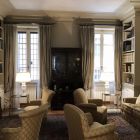Addis Ababa gives the impression of a capital that is looking to the future while still being firmly rooted in the past. Its fabric bears witness to the various stages in its history, from its imperial origins in the late 1880s through the Italian colonial occupation of 1936-41 to the Marxist dictatorship of 1974-1991. Now partial liberalisation has triggered a spate of private development, with slick new hotels, commercial and residential buildings going up in many parts of the city at breakneck speed. Democratic reform has followed a more turbulent path and violent political unrest following contested parliamentary elections in May 2005 was a reminder that the situation in the country remains volatile. Addis Ababa hangs loosely around the old market area of Arada at the northern end of Churchill Avenue and the newer commercial and administrative district to the south. Most residents live in extremely poor conditions in densely populated areas around this central axis; rich Ethiopians and foreigners are scattered across the rest of the city, with concentrations in the area south of Old Lideta Airport (Mekanisa) to the southwest and in the areas of new expansion to the east and southeast. Addis Ababa has a large diplomatic community centred around the United Nations Economic Commission for Africa and the African Union, both of which are headquartered here. Expatriate housing has traditionally been in bungalows and larger houses in their own compounds, although apartments in low-rise blocks are beginning to catch on. Good private accommodation is now easy to find. Fresh food is readily available and extremely cheap; electrical appliances can be found in Addis Ababa but the choice is limited and most foreigners import these and other major household items. The decentralised nature of the city combined with its altitude (at around 2,500 m above sea level it is the third highest capital in the world) and heavy pollution can make getting about on foot a chore but there is a cheap and very efficient network of minibuses serving all areas. By all standards, Addis Ababa feels, and is, extremely safe.
Addis Ketema/Merkato
Addis Ketema, meaning New Town in Amharic, due west of Arada, is best known for its open market, Merkato, which competes with Roque Santeiro in the Angolan capital Luanda and Oshodi market in Lagos (Nigeria) for the title of largest market in Africa. Here it is possible to find literally everything, from spices to fabrics, gold jewellery to western-style clothes. The area also boasts a large grain market near Amanuel Mental Hospital, the only specialist psychiatric hospital in Ethiopia. Somali Tera, between Merkato and Arada, is the place to go for spare parts for cars. The central wholesale fruit and vegetable market, Atikilt Tera, is also located in this part of town. Local shopkeepers and stallholders live in poor conditions in the densely populated residential areas on the edge of Merkato or in more salubrious accommodation in the neighbouring Kolfe district on the far side of the ring road bordering the area to the west. There is little available rental accommodation in this area. The local roads are heavily congested with people and traffic a problem compounded by the presence of the citys long-distance bus station in the heart of the area and security is not as good as in other parts of the city. The Grand Anwar Mosque, a small synagogue and numerous Orthodox Christian churches are located in this area.
Arada
Arada is one of the oldest parts of Addis Ababa and also one of the areas where the early history of the city is most apparent. Its narrow, sloping streets are dotted with beautiful old one- and two-storey buildings variously adorned with verandas, pillars, bay windows and other decorations in accordance with Indian, Middle-Eastern and European styles. Sadly, many of them are in extremely poor repair. The area also has its fair share of newer-build low-rise concrete residential and office blocks, especially along the main roads. At the heart of the district lies Piazza (pronounced Piassa), a bustling commercial area centred around De Gaulle Square; the imposing city hall, the seat of the city government, constructed in 1965, and the octagonal neoclassical St Georges Cathedral (Ethiopian Orthodox), built to mark Emperor Meneliks defeat of the Italians in the battle of Adwa in 1896 and named after the patron saint of Ethiopia, are also to be found here. Its busy roads are lined with shops and boutiques selling European clothes, jewellery and all manner of other goods at prices that are generally higher than in other parts of the city. Both the shopkeepers and their customers hail from other areas of the capital; Arada itself is home to low-income workers living in small state-owned houses and shanty dwellings directly behind the rows of shops. Piazza is also the location of the Greek and Armenian Orthodox churches, testifying to two of the oldest foreign communities in the city. To the east of Piazza, there is a kind of educational, cultural and administrative zone around Arat Kilo and Sidist Kilo on the Entoto Road heading north, which includes the university of Addis Ababa the scene of bloody riots in April 2001 the state-owned Ethiopian Press Agency, numerous federal government ministries and several museums. The office of the prime minister, the presidential palace and parliament are also located near here. In Arada good rental accommodation is in short supply and in high demand. The area is served by minibuses heading in all directions.
Aware
This quiet, leafy residential area to the east of the centre contains a mix of accommodation, from attractive bungalows and larger houses in spacious compounds to much more modest homes. The proximity to parliament and key offices of state means that security here is particularly good. St Matthews Anglican Church and Sandford English Community School, offering a primary and secondary education in English leading to IGCSE examinations and the international baccalaureate, are both situated here. Several embassies have their premises in the sub-area known as Kebena to the north. The Italian-designed Africa Hall, built by Emperor Haile Selassie to house the United Nations Economic Commission for Africa in 1961, is located on Menelik II Avenue to the south. Shopping is almost entirely at roadside kiosks; for more substantial purchases it is necessary to make the trip into Arat Kilo (two kilometres) or Piazza (four kilometres). Public transport is scarcer here than in other parts of the city and it is useful to have a car.
Bole
This is a new area expanding to the southeast of the city centre and is a favourite with high-income Ethiopians and the international community; many diplomatic missions and aid agencies are located here. Housing is mostly in new-build houses or slightly older bungalows in leafy, gated compounds; apartments are in limited supply. Bole Road running southeast from Meskel Square to the airport boasts an excellent selection of shops, supermarkets and fashionable new bars, pubs and eateries, including the landmark Dembel City Center the one and only complete shopping center in Ethiopia offering over 100 shops, a snack bar and restaurant and an underground carpark for 500 vehicles. The area is well served by buses, minibuses and taxis; it is also bordered by the ring road. Away from the main roads it is quiet and there is plenty of space, in stark contrast to the older and more densely populated areas of the city to the north and west. At the centre of Bole on the West Bole Road stands the newly built Bole Medhane Alem cathedral (Ethiopian Orthodox), reputedly the largest church in Addis Ababa and the second largest in Africa, surrounded by (currently) open land a veritable cathedral in the desert. Further north, around Haile Gebreselassie Road (formerly Asmara Road, and renamed after Ethiopias most popular long-distance runner), lies Boles downmarket sister Urael, a quiet residential area populated by a mix of middle- and low-income groups living in a variety of housing of old and newer build.
Gerji
This new settlement, just off the ring road to the east of the city and close to the international airport, offers a mix of residential and commercial property, much of which is under construction. Consequently, there is a heavy through flow of construction vehicles, which are tearing up the roads. Housing is a combination of modest bungalows, two-storey houses and apartments in low-rise blocks. There is a limited selection of shops and other services. This area is served by public transport but services are less efficient than in other parts of the city and it is useful to have a car. To the north of Gerji there is a small industrial area specialising in aluminium, packaging and coffee exports. Coffee is widely believed to have originated in Ethiopia, taking its name from the southwestern highland district of Kaffa where coffee arabica grew wild. Now it is grown as a cash crop in many parts of the south and east and is critical to the countrys economy as well as being an integral part of Ethiopian culture and hospitality.
Gofa Sefer/Nefas Silk
Gofa Sefer, beyond Cherkos and Kera to the south, is a densely populated and heavily congested residential and commercial district specialising in spare parts for heavy vehicles. Housing is mainly in small state-owned homes and shanty dwellings. Still further to the south on Debre Zeit Road lies Nefas Silk, the citys main industrial area. Bounded by the ring road to the east and just a short distance from Bole international airport, it hosts a large concentration of light industries manufacturing textiles, soap, foam and hides, among other things. The main roads are extremely congested with people and traffic and pollution is bad. Debre Zeit Road leads to the volcanic region of Debre Zeit, some 45 kilometres southeast of the capital, whose seven crater lakes are a magnet for bird life.
Gulele
This hilly area northwest of Arada has seen a recent influx of middle-income Ethiopians attracted by the combination of space and proximity to the city centre. However, it remains true to its original identity as a low-income area supporting a small cluster of light industries along the road leading northwest out of the city; and here, as in many other parts of Addis Ababa, the poor and less poor live cheek-by-jowl. Basic foods can be bought easily and cheaply throughout the area; there is also a regular fresh produce market and a market selling second-hand clothes. Sheger Park, on the busy road running southeast into Arada, can be hired for wedding receptions, graduation ceremonies and other important functions. Just to the south of the park, there is a crafts market on Wednesday and Saturday mornings. The Greek, Italian and Addis Ababa Commonwealth War Graves cemeteries and the General Wingate School, named after the British general who played a key role in Ethiopias liberation in 1941 and which counts incumbent prime minister Meles Zenawi among its alumnae, are also located in this area.
Kechene
Stretching north from Arada almost to Entoto, the site of Ethiopias itinerant capital before Emperor Menelik founded Addis Ababa in 1887, this quiet, leafy residential area is home to a close-knit community of low-income potters and weavers, groups that are traditionally ostracised by Ethiopian society as they are widely believed to have the power of the evil eye. There are no foreigners living in this area. Daily life revolves around the church of Kechene Medhane Alem (Ethiopian Orthodox) at the geographical centre of the district. Housing is a mix of small state-owned homes and shanty dwellings strung out along mud roads that dip and rise through lush vegetation and small plots of land. The area is dotted with small shops and roadside kiosks selling only the most basic items; the area is also home to a colourful handicrafts and traditional clothes market at Shiro Meda, the just north of the heavily guarded United States embassy on the Entoto Road, where many of the local craftspeople peddle their wares. The commercial districts of Piazza and Arat Kilo are both within easy reach by public transport.
Kotebe/CMC
This area 12 km east of the city centre, also known as civil service area after the Ethiopian Civil Service College located here, is undergoing a process of rapid growth due to the availability of cheap land. Housing is typically in bungalows or two/three-storey houses in small compounds. There are plenty of small shops and kiosks along the main road for essential supplies; traffic is heavy, especially at rush hour, when it can be difficult to catch a minibus into town. Owning a car here is a plus. Off the main road, the area is quiet but the roads are in poor condition. To the south, on the southern side of the road leading due east out of Addis Ababa, lies CMC, a new residential compound popular with expatriates. Named after the Italian construction company that built it in the early 1990s, it consists of 500 homes apartments and two-storey townhouses of varying sizes in a secure compound with a well-tended garden. Two price systems, one for Ethiopians and the other for foreigners, apply. Rents are higher here than in other parts of Kotebe. The compound has two supermarkets, a gym and a childrens playground, as well as parking. To the south there are construction sites as far as the eye can see.
Lagare
This area at the southern end of Churchill Avenue is the nearest thing the city has to a central business district. There is a small cluster of commercial and government buildings and hotels centred around the railway station, dating from the completion of the French-built Djibouti-Addis Ababa railway in 1917, which gives the area its name. There is a limited amount of residential accommodation, mostly in characterless concrete apartment blocks overlooking the main roads. There is one good supermarket on Churchill Avenue, opposite the Lyce Franco-Ethiopienne, as well as numerous pastry shops a favourite with office workers at lunchtime. The busy shopping areas of Piazza and Merkato are only a short minibus ride (or a longer walk) uphill. The national theatre and the football stadium are also in this area. Immediately to the south lies Cherkos, a densely-populated area inhabited by the poor and very poor, living in slums and very modest state-owned homes. Still further south is Kera, another crowded low-income area famous for its abattoir. If the wind is blowing in the wrong direction the smell can be overpowering.
Lideta
Crowded Lideta southwest of the city centre is home to a mostly low-income population comprising day labourers, manual workers and low-level civil servants living mostly in state-owned houses in poor conditions. The Balcha Hospital, a specialist lung hospital founded by the Russian Red Cross in 1946, is a local landmark, and several Russian doctors still work there to this day. Round the corner from the hospital is one of several Etfruit markets run by the Ethiopian Fruit and Vegetables Marketing Enterprise, the major domestic distributor and exporter of local produce in the capital, selling quality fresh fruit and vegetables and fruit juice at competitive prices. (The same products can also be purchased from distinctive green and white mobile units around the city.) Mexico Square between Lideta and Lagare is a key public transport hub, ensuring a good bus and minibus service but also heavy traffic.
Mekanisa (Old Airport)
This wealthy area, popular with the large expatriate community, is south of old Lideta airport, from which it takes its alternative name. Numerous diplomatic missions have their offices and/or residences here. Housing is mostly in villas in large, secure compounds; however, here as in other parts of the city security is typically low-key. Property is older than in Bole and CMC, the areas of new expansion also popular with foreigners, although there is also some new development, especially in the less populous area to the south. There is a cluster of more exclusive homes around Bisrate Gebriel church (Ethiopian Orthodox) in the heart of the area. The International Community School (US curriculum, pre-kindergarten to grade 12) is just a few steps away. Traffic on the main thoroughfares is heavy at all times of the day but away from the roads the area is quiet. Herds of goat being driven along the lanes or grazing by the roadside give a rural feel. Fantu supermarket and Shoppers Mart near the Old Airport offer a good selection of local and imported products; the latter is open 24 hours a day. Both have community notice boards for local news and events. Nearby on Pushkin Square is Adams Pavilion, a glistening new - but largely empty - shopping mall with four floors of boutiques, a bookshop and Kaldis Coffee (a kind of Ethiopian Starbucks) among other things. The African Union building is located on Roosevelt Street just to the north. The international tennis club and the Addis Ababa golf club are both to be found here.
Yeka
This mixed-income area east of the city centre offers a variety of housing from modest bungalows in small, gated compounds to shanty dwellings. There is a higher population density here than in neighbouring Aware and traffic is heavy along the one main road. Elsewhere in the area, infrastructure is poor. Yeka Park, just a few steps from Yeka Mikael church (Ethiopian Orthodox), offers a haven of peace in a lush, well-tended environment; facilities include a childrens playground and a bar, popular with students in search of an alternative to the citys crowded libraries. Entrance costs 1 Birr; the park can also be booked for private functions. Basic goods can be bought from the numerous shops and stalls along the main road; otherwise it is necessary to make the six-kilometre trip into town. Yeka also marks the start of the new ring road linking the east of the city with Bole international airport in the southeast, the industrial area in Nefas Silk to the south, Old Airport (Mekanisa) to the west and Gulele in the northwest.









